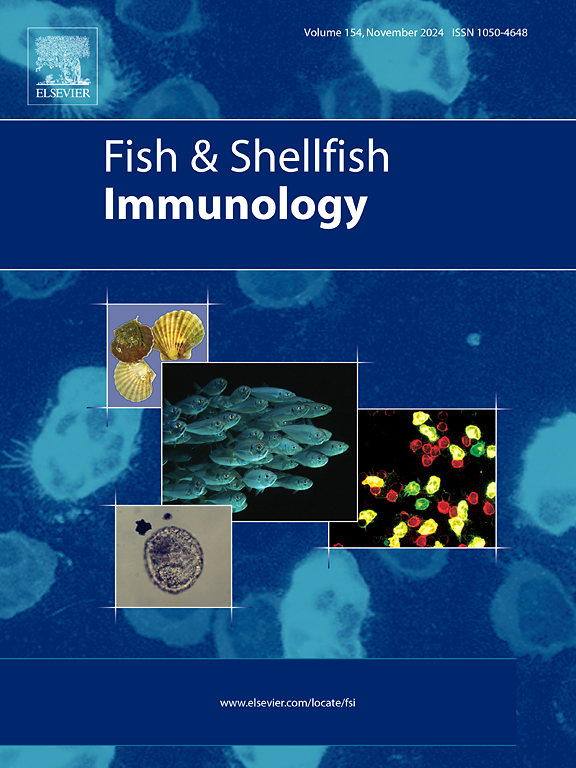The protective effect of specific yolk antibody against nervous necrosis virus infection in Mandarin fish(Siniperca chuatsi)
IF 4.1
2区 农林科学
Q1 FISHERIES
引用次数: 0
Abstract
Nervous necrosis virus (NNV), a member of the Nodavirus genus, is a highly contagious disease that is found all over the world. As of right now, there aren't many reliable commercial vaccines available to combat this infection. In a previous study, we isolated a Mandarin fish (Siniperca chuatsi)-derived NNV strain, tentatively named MFNNV. By immunizing hens with MFNNV recombinant capsid protein (CP), this study produced high-purity anti-MFNNV yolk antibodies. According to the ELISA results, the purified anti-MFNNV IgY titer peaked at week 8 after the first vaccination; western blotting and indirect immunofluorescence results showed that IgY could act as a primary antibody to specifically recognize recombinant CP and virus particles. At the cellular level, specific IgY significantly reduced the appearance of vacuolated cytopathic effect in GS cells after incubation with an equal volume of virus compared with non-specific IgY. Mandarin fish was fed diets supplemented with anti-MFNNV IgY or non-specific IgY at 33 % (w/w) for 7 days prior to artificial infection with MFNNV. On the 14th day of artificial infection with MFNNV, the mortality rate was 53.3 % in the specific group and 83.3 % in the nonspecific group, and the relative protection rate of the specific IgY group was about 36 % compared with that of the nonspecific IgY group. In histopathological analysis, vacuolizing lesions were observed in the brain tissues of Mandarin fish in the non-specific group, whereas only slight vacuolization was observed in the brain tissues of the specific group. Further analysis revealed that compared with the non-specific group, the MFNNV-CP gene expression in the eyes as well as the brain of Mandarin fish in the specific group showed a significant decrease, and the mRNA expression levels of immune-related factors, such as TNF-α, IFN-h, IL-1, IL-8, Mx proteins, and IgM in the spleen, liver, kidney, and hindgut tissues of the specific group also showed a decrease of varying degrees, suggesting that oral administration of specific IgY could neutralize virus and reduce the immune responses as well as tissue pathological damage induced by the Nervous necrosis virus. Consequently, we suggested that IgY could protect Mandarin fish from MFNNV infection by acting as a passive immunological measure.
特异性卵黄抗体对鳜鱼神经坏死病毒感染的保护作用
神经坏死病毒(NNV)是诺达病毒属的一种成员,是一种遍布全球的高度传染性疾病。到目前为止,还没有多少可靠的商业疫苗可用于抗击这种感染。在之前的一项研究中,我们分离出了一种由鳜鱼(Siniperca chuatsi)衍生的 NNV 病毒株,并将其暂定名为 MFNNV。通过用 MFNNV 重组囊壳蛋白(CP)免疫母鸡,本研究产生了高纯度的抗 MFNNV 卵黄抗体。ELISA结果显示,纯化的抗MFNNV IgY滴度在首次免疫后第8周达到峰值;Western印迹和间接免疫荧光结果显示,IgY可作为特异性识别重组CP和病毒颗粒的第一抗体。在细胞水平上,与非特异性 IgY 相比,特异性 IgY 能显著减少 GS 细胞在与等体积病毒孵育后出现的空泡细胞病理效应。在鳜鱼人工感染 MFNNV 之前,喂食添加 33%(重量/重量)抗 MFNNV IgY 或非特异性 IgY 的饲料 7 天。在人工感染 MFNNV 的第 14 天,特异性组的死亡率为 53.3%,非特异性组为 83.3%,特异性 IgY 组的相对保护率约为非特异性 IgY 组的 36%。在组织病理学分析中,非特异性组的鳜鱼脑组织中观察到空泡化病变,而特异性组的脑组织中仅观察到轻微的空泡化。进一步分析发现,与非特异性组相比,特异性组鳜鱼眼部和脑部的 MFNNV-CP 基因表达量显著下降,免疫相关因子,如 TNF-α、IFN-h、IL-1、IL-8、Mx 蛋白等的 mRNA 表达水平也显著下降、这表明口服特异性 IgY 可中和病毒,减轻神经坏死病毒引起的免疫反应和组织病理损伤。因此,我们认为 IgY 可作为一种被动免疫措施,保护鳜鱼免受 MFNNV 感染。
本文章由计算机程序翻译,如有差异,请以英文原文为准。
求助全文
约1分钟内获得全文
求助全文
来源期刊

Fish & shellfish immunology
农林科学-海洋与淡水生物学
CiteScore
7.50
自引率
19.10%
发文量
750
审稿时长
68 days
期刊介绍:
Fish and Shellfish Immunology rapidly publishes high-quality, peer-refereed contributions in the expanding fields of fish and shellfish immunology. It presents studies on the basic mechanisms of both the specific and non-specific defense systems, the cells, tissues, and humoral factors involved, their dependence on environmental and intrinsic factors, response to pathogens, response to vaccination, and applied studies on the development of specific vaccines for use in the aquaculture industry.
 求助内容:
求助内容: 应助结果提醒方式:
应助结果提醒方式:


